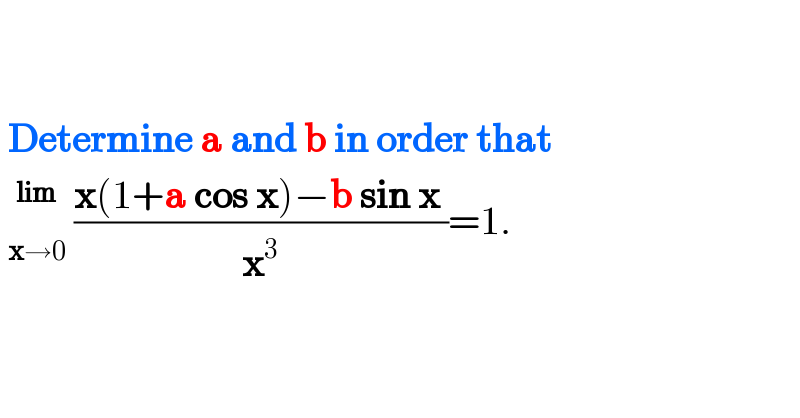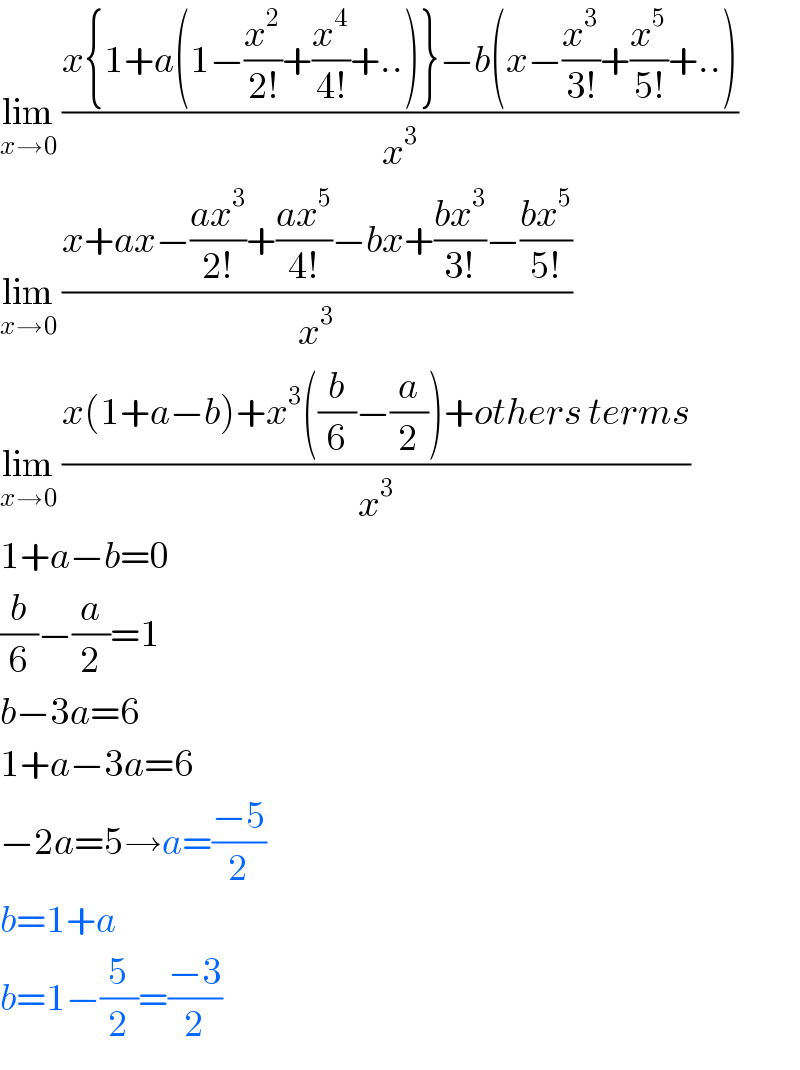
Question Number 84065 by niroj last updated on 09/Mar/20

$$ \\ $$$$\: \\ $$$$\:\boldsymbol{\mathrm{Determine}}\:\boldsymbol{\mathrm{a}}\:\boldsymbol{\mathrm{and}}\:\boldsymbol{\mathrm{b}}\:\boldsymbol{\mathrm{in}}\:\boldsymbol{\mathrm{order}}\:\boldsymbol{\mathrm{that}} \\ $$$$\:\underset{\boldsymbol{\mathrm{x}}\rightarrow\mathrm{0}} {\overset{\boldsymbol{\mathrm{lim}}} {\:}}\:\frac{\boldsymbol{\mathrm{x}}\left(\mathrm{1}+\boldsymbol{\mathrm{a}}\:\boldsymbol{\mathrm{cos}}\:\boldsymbol{\mathrm{x}}\right)−\boldsymbol{\mathrm{b}}\:\boldsymbol{\mathrm{sin}}\:\boldsymbol{\mathrm{x}}\:}{\boldsymbol{\mathrm{x}}^{\mathrm{3}} }=\mathrm{1}. \\ $$
Commented by mathmax by abdo last updated on 09/Mar/20

$$\Rightarrow{lim}_{{x}\rightarrow\mathrm{0}} \:\:\:\:\frac{{x}\left(\mathrm{1}+{acosx}\right)−{bsinx}}{{x}^{\mathrm{3}} }−\mathrm{1}\:=\mathrm{0}\:\Rightarrow \\ $$$${lim}_{{x}\rightarrow\mathrm{0}} \:\:\:\:\:\frac{{x}\left(\mathrm{1}+{acosx}\right)−{bsinx}−{x}^{\mathrm{3}} }{{x}^{\mathrm{3}} }\:=\mathrm{0}\:\Rightarrow \\ $$$${u}\left({o}\right)={u}^{'} \left(\mathrm{0}\right)\:={u}^{\left(\mathrm{2}\right)} \left(\mathrm{0}\right)={u}^{\left(\mathrm{3}\right)} \left(\mathrm{0}\right)=\mathrm{0}\:\:{and}\:{v}\left(\mathrm{0}\right)={v}^{'} \left(\mathrm{0}\right)={v}^{\left(\mathrm{2}\right)} \left(\mathrm{0}\right)={v}^{\left(\mathrm{3}\right)} \left(\mathrm{0}\right)=\mathrm{0}\:{with} \\ $$$${u}\left({x}\right)={x}\left(\mathrm{1}+{acosx}\right)−{bsinx}\:−{x}^{\mathrm{3}} \\ $$$${u}\left(\mathrm{0}\right)=\mathrm{0}\:\Rightarrow\mathrm{0}=\mathrm{0}\:\left({v}\right) \\ $$$${u}^{'} \left({x}\right)=\mathrm{1}+{acosx}\:+{x}\left(−{asinx}\right)−{bcosx}−\mathrm{3}{x}^{\mathrm{2}} \\ $$$${u}^{'} \left(\mathrm{0}\right)=\mathrm{0}\:\Rightarrow\mathrm{1}+{a}−{b}\:=\mathrm{0}\:\Rightarrow{b}=\mathrm{1}+{a} \\ $$$${u}^{\left(\mathrm{2}\right)} \left({x}\right)\:=−{asinx}\:−{asinx}\:+{x}\left(−{acosx}\right)+{bsinx}\:−\mathrm{6}{x}\: \\ $$$${u}^{\left(\mathrm{2}\right)} \left(\mathrm{0}\right)=\mathrm{0}\:\Rightarrow\mathrm{0}=\mathrm{0}\:\left({v}\right) \\ $$$${u}^{\left(\mathrm{3}\right)} \left({x}\right)=−\mathrm{2}{acosx}\:−{acosx}\:+{axsinx}\:+{bcosx}\:−\mathrm{6}\: \\ $$$${u}^{\left(\mathrm{3}\right)} \left(\mathrm{0}\right)=\mathrm{0}\:\Rightarrow−\mathrm{3}{a}\:+{b}\:−\mathrm{6}\:=\mathrm{0}\:\Rightarrow{b}=\mathrm{3}{a}+\mathrm{6}\:\Rightarrow\mathrm{1}+{a}=\mathrm{3}{a}+\mathrm{6}\:\Rightarrow\mathrm{2}{a}+\mathrm{6}=\mathrm{1}\:\Rightarrow \\ $$$${a}=−\frac{\mathrm{5}}{\mathrm{2}}\:\:{and}\:{b}=−\frac{\mathrm{3}}{\mathrm{2}}\:\:\:\left({for}\:{v}\:{the}\:{conditions}\:{is}\:{verified}..\right) \\ $$$$ \\ $$
Commented by mathmax by abdo last updated on 09/Mar/20

$${v}\left({x}\right)={x}^{\mathrm{3}} \\ $$
Answered by TANMAY PANACEA last updated on 09/Mar/20

$$\underset{{x}\rightarrow\mathrm{0}} {\mathrm{lim}}\:\frac{{x}\left\{\mathrm{1}+{a}\left(\mathrm{1}−\frac{{x}^{\mathrm{2}} }{\mathrm{2}!}+\frac{{x}^{\mathrm{4}} }{\mathrm{4}!}+..\right)\right\}−{b}\left({x}−\frac{{x}^{\mathrm{3}} }{\mathrm{3}!}+\frac{{x}^{\mathrm{5}} }{\mathrm{5}!}+..\right)}{{x}^{\mathrm{3}} } \\ $$$$\underset{{x}\rightarrow\mathrm{0}} {\mathrm{lim}}\:\frac{{x}+{ax}−\frac{{ax}^{\mathrm{3}} }{\mathrm{2}!}+\frac{{ax}^{\mathrm{5}} }{\mathrm{4}!}−{bx}+\frac{{bx}^{\mathrm{3}} }{\mathrm{3}!}−\frac{{bx}^{\mathrm{5}} }{\mathrm{5}!}}{{x}^{\mathrm{3}} } \\ $$$$\underset{{x}\rightarrow\mathrm{0}} {\mathrm{lim}}\:\frac{{x}\left(\mathrm{1}+{a}−{b}\right)+{x}^{\mathrm{3}} \left(\frac{{b}}{\mathrm{6}}−\frac{{a}}{\mathrm{2}}\right)+{others}\:{terms}}{{x}^{\mathrm{3}} } \\ $$$$\mathrm{1}+{a}−{b}=\mathrm{0} \\ $$$$\frac{{b}}{\mathrm{6}}−\frac{{a}}{\mathrm{2}}=\mathrm{1} \\ $$$${b}−\mathrm{3}{a}=\mathrm{6} \\ $$$$\mathrm{1}+{a}−\mathrm{3}{a}=\mathrm{6} \\ $$$$−\mathrm{2}{a}=\mathrm{5}\rightarrow{a}=\frac{−\mathrm{5}}{\mathrm{2}} \\ $$$${b}=\mathrm{1}+{a} \\ $$$${b}=\mathrm{1}−\frac{\mathrm{5}}{\mathrm{2}}=\frac{−\mathrm{3}}{\mathrm{2}} \\ $$
Commented by niroj last updated on 09/Mar/20

$${exellent}\:{dear}\:.{thank}\:{you}\:{so}\:{much}. \\ $$
Commented by TANMAY PANACEA last updated on 09/Mar/20

$${most}\:{welcome}\:{sir} \\ $$
